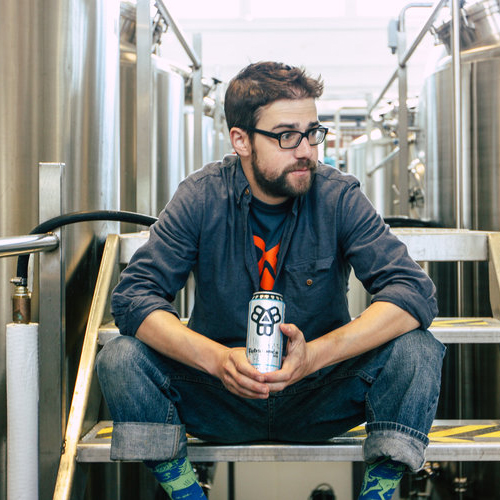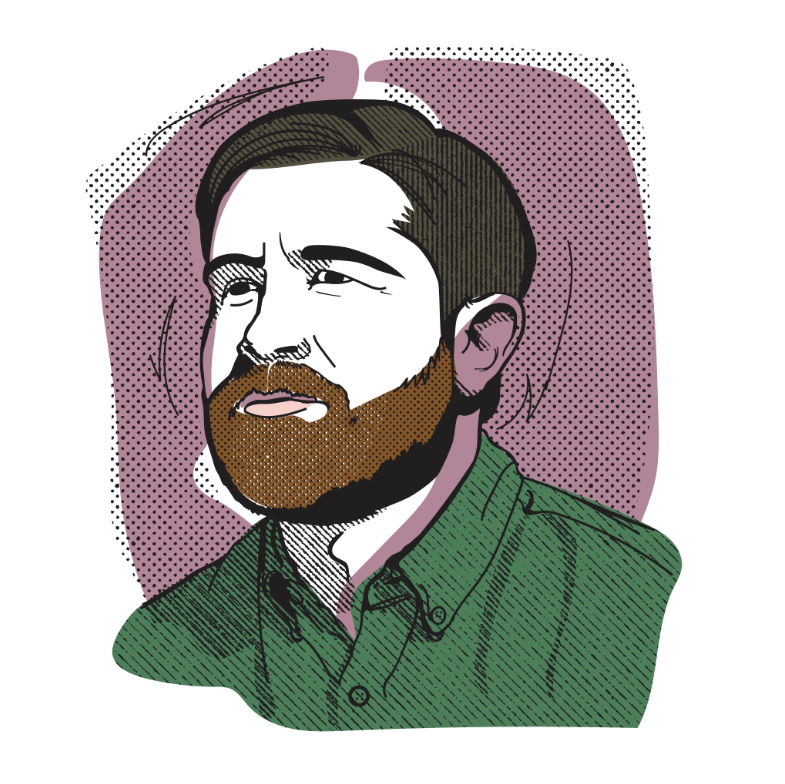In a corporate conference center nestled above the White Labs’ Tasting Room—a 32-tap handle bar built for the social, sensory experimentation of beer—there are gallery picture frames decorating the walls. One frame displays the Federal trademark for “White Labs Yeast.” Another, the trademark for “Purepitch,” the latest and greatest technology that the company uses to package both homebrew and commercial size pitches of yeast. In the last frame is U.S. Patent No. 8,802,421 B2 titled “Method of Propagating and Delivering Yeast.” Inventor: “Chris White.”
Chris walks into the room wearing pressed jeans and a brown sport coat, with his arm outstretched for a handshake and with a loose smile on his face: “Welcome to White Labs Yeast.”
First and foremost, Chris White is a brewer. He’s an inventor. He’s an author. He’s a teacher. He’s a board game creator. He’s got a PhD in biochemistry. But most importantly, he’s the Founder, President, and CEO of White Labs Inc. Pure Yeast and Fermentation. Celebrating its 20th Anniversary, White Labs is now a global operation with five locations—San Diego, California; University of California, Davis; Boulder, Colorado; Asheville, North Carolina; Copenhagen, Denmark (at the ultra-new Warpigs Brewpub location, a collaborative joint started by Mikkeller and 3 Floyd’s), and Hong Kong, China. The company employs more than 100 people—some of the brightest minds in beer business.
“We’re here to serve the craft brewing industry. We produce the highest quality yeast cultures,” Chris says. “We focus on the microbiology of beer fermentation. Making the best yeast is our best niche. It’s great to be a part of it all.”
Today, White Labs, along with Wyeast, are the two oldest, largest, and perhaps most-preeminent, industry-leading producers of yeast. Of course, it wasn’t always this way. The story of White Labs is the story of San Diego beer. Chris began his higher education at UC Davis (today, it’s one of the leading brewing schools in the nation), enrolling in Dr. Michael Lewis’ upper division Brewing and Malting Science course.
After graduation, Chris moved to San Diego to study biochemistry at U.C. San Diego. There, he met Yuseff Cherney (now of Ballast Point). Chris signed up for Yuseff’s course because he wanted to learn how to brew all-grain. The two guys quickly became friends. “I think Yuseff liked me because I worked in a lab,” Chris imagines.
Whatever brought the two together, they started homebrewing, 15 gallons of beer each batch. With these batches, Yuseff was developing the recipes and the concepts for Ballast Point and Chris was developing White Labs’ yeast.
“We looked at moving White Labs’ headquarters, but we can’t get out of this town. This is mecca, and we need to support craft beer here first.”
In 1995, Chris officially started White Labs. And it started slowly.
“I just liked hanging around Homebrew Mart," he says. "A lot.”
Chris started making yeast for the homebrew shop, supplying the yeast for the San Diego homebrewing community, for brewers who would go on to launch the innumerous brewing ventures here in the county.
“It was fun watching all of the start-ups here, especially early on," he says. "Pizza Port, Karl Strauss, and Stone. I remember standing with Greg [Koch] and Steve [Wagner] in a big empty warehouse—I was into the brewing scene, even back then. I liked the beer that was being brewed.”
When Pizza Port opened in Solana Beach, Chris started hanging around there, too. A lot. He liked the beer and he liked talking with Vince Marsaglia. Chris quickly landed White Labs’ first commercial client, trading pitches of yeast for pizzas. White Labs became the go-to yeast producer for local San Diego breweries. And then for national breweries. And then for international breweries.
“The majority of our clients are craft breweries—of all sizes, but primarily at the scale of 1,000 barrels-plus a year," Chris says. "We also grow cultures for homebrewers and for wineries and distilleries too.”
The company isolates and propagates its own propriety cultures—these are the numbered yeast strains that every brewer has come to know and recognize, the WLP001’s and the WLP002’s, the WLP300’s and the WLP500’s. But the company will also bank brewer’s own yeast strains, the house cultures that make a brewery’s beer definitively unique. These house yeast strains have grown to make up a fair percentage of White Labs’ business.
“We focus heavily on helping to solve the mysteries surrounding the genetics of yeast. What genes are involved in yeast flocculation? What specific genes make yeast strains different? We want to understand yeast health. Yeast contributes over five hundred flavor and aroma compounds to beer, and we want understand those better.”
There is noticeable focus on the identity, on the essence of each yeast strain. As beer continues to evolve toward regionality, we are seeing hybrid strains and local and regional strains becoming more of a focus, even at White Labs. Is there going to be a day where we can purchase a regionally-specific, funky yeast strain to pitch at a brewery on the other side of the world? Chris is hesitant to say either way, but he brings a historical perspective to it all.
“A lot of the strains that we are using for American craft beers today are European in origin and region," he says. "I’m interested in the evolution and hybridization and localization of yeast on the microbiological and genetic levels.” This holds true, whether clean or funky.
Supporting the funky, saison, and farmhouse trends, the company offers a number of wild yeast strains as well as microbacteria for souring beer. Perhaps the strongest way White Labs’ continues to support the breweries that are driving the innovative trends in yeast is through the incredibly in-depth levels of research and the investment that the company pours into yeast.
“We focus heavily on helping to solve the mysteries surrounding the genetics of yeast," Chris says. "What genes are involved in yeast flocculation? What specific genes make yeast strains different? We want to understand yeast health. Yeast contributes over five-hundred flavor and aroma compounds to beer, and we want understand those better.”
The company receives commercial beer samples every day for analytical purposes, and that side of the program is continuing to expand. “Quality is top-of-mind for this industry right now, and I think that brewers get that,” Chris says.
White Labs’ offers a “Big QC Day” twice a year, where it opens its analytical services up to everyone in the craft brewing industry. Not only do the brewers benefit from having their beer analyzed, but White Labs gains the opportunity to capture data and follow trends on an industry-wide level. Along with that QC comes a focus on education—White Labs’ facility in San Diego includes a classroom for seminars and workshops, and the company has hosted classes in other cities for the homebrewer and for the professional brewer.
At the end of the day, though, White Labs makes yeast. Period.
“Making yeast is difficult,” Chris says. “We can’t just rest on making good cultures. We need to develop and embrace new technologies and quality systems. You need to build QC control into all of your processes, and that’s what we are trying to do with our systems…looking five, 10 years down the road.”
As challenges and risks emerge (a brewery client who is too small to afford or care about a proper lab and yeast management, or competition from a small, niche yeast producer like GigaYeast), White Labs is up for it. They've seen folks start up and fail, both brewers and yeast manufactures alike. But they've also got respect for anyone who can do it. In fact, White Labs has helped folks make their way, including start-ups like The Yeast Bay and small start-up breweries here in San Diego.
There is a major push forward occurring at all levels for White Labs as a company. The new locations and facilities will support the localization of beer. It’s all about providing the freshest yeast, closer to the people who need it. The beer industry is going global, in a big way. Asia has a lot of wealth, and is perhaps the biggest next test for craft beer. If craft can gain a foothold, if it can be compelling, it could go a long way in the Asian markets like Hong Kong and Beijing. There are literally millions of thirsty people over there.
It’s no coincidence that White Labs is located there now too. Europe is stepping up its game as well. Chris also points to Germany as a brewing nation that could be really powerful in craft beer, building off its historical brewing tradition but embracing the new-school American-style brewing philosophy that other European brewers like Mikkeller are riding. But, White Labs’ future is clearly rooted in San Diego.
“It’s where we started,” Chris says. “We looked at moving White Labs’ headquarters, but we can’t get out of this town. This is mecca, and we need to support craft beer here first.”
Building a quality brewery is like building a team. White Labs’ is—and has been—a key component of that team for so many brewers in San Diego, and throughout the world. After all, brewers make wort, but yeast makes beer. You don’t have to be a Ph.D. in microbiology to grok that.
























